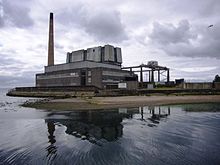- Methil power station
-
Methil power station 
The station in July 2006Country Scotland Location Levenmouth, Fife Coordinates 56°11′27″N 2°59′48″W / 56.190918°N 2.996732°WCoordinates: 56°11′27″N 2°59′48″W / 56.190918°N 2.996732°W Commission date 1965 Decommission date 2000 Operator(s) South of Scotland Electricity Board Power station information Primary fuel Coal-fired grid reference NO381002 Methil Power Station was a small base load coal slurry-fired power station in the town of Methil, Fife, Scotland. It was situated on the south side of the mouth of the River Leven, where the river enters the Firth of Forth.
It was a local landmark, with the chimney (lum) visible for some distance.
Contents
Design
The power station consisted of two 30 megawatt (MW) generation units for a peak rating of 57 MWe. It was commissioned in 1965 for the then South of Scotland Electricity Board. Built on the site of a golf course, it was constructed to utilise low-grade coal-slurry supplied from the washeries of the nearby Fife coalfield. This coal was delivered by both road and rail wagons shunted into and out of elevated sidings. Like nearly all other coal-fired power stations in Scotland, Methil Power Station didn't use cooling towers, instead using sea water as coolant. An exception was Methil's sister station of Barony, situated in central Ayrshire.
History
This station was built as a sister to Barony Power Station on the West Coast of Scotland, in Ayrshire. Although the design of Methil was based on that of Barony, it incorporated many improvements. As the Scottish coalfields were exhausted or abandoned in the mid-1980s, waste accumulated in coal tips, and this waste was used as a fuel in the Methil and Barony power stations.[citation needed] However, as the tips were cleared, operations at the two stations ceased due to lack of coal-slurry fuel and the uneconomical operation of such small facilities. In the late 1990s it was used for trial burning of sewage waste using one of the two 30 MW boiler.[citation needed]
This station was decomissioned in 2000 and finally demolished in 2011 as part of a regeneration of this area. The preferred redevelopment option for the site is for leisure and tourism. A development of a retail park or shopping centre is also being considered.
Demolition
Demolition is complete. The main part was spectacularly demolished on 20 April 2011. The Chimney stack was demolished on 8 June 2011 at 1430 BST. A massive crowd gathered for the demolition of the main part. The only downside to it was the fog rolling in off the sea. It came in 10 mins before demolition, then disappeared about an hour after it. Even so, the crowd wasn't disappointed and cheers were heard as it fell. Locals said it has been an eyesore for many years, but will miss seeing it on the local landscape.[1][2]
References
- ^ http://www.fife.gov.uk/news/index.cfm?fuseaction=feature.display&objectid=AF216643-ABEC-010C-D26EFD7B6E1F9165 Fife Council information about regeneration of the area.
- ^ http://lpconsult.fife.gov.uk/portal/kirkcaldy_and_mid_fife_local_plan_documents/sea/dkmflpn2000aa?pointId=1224502424229#section-1224502424229
External links
Categories:- Buildings and structures in Fife
- Levenmouth
- Fife
Wikimedia Foundation. 2010.

